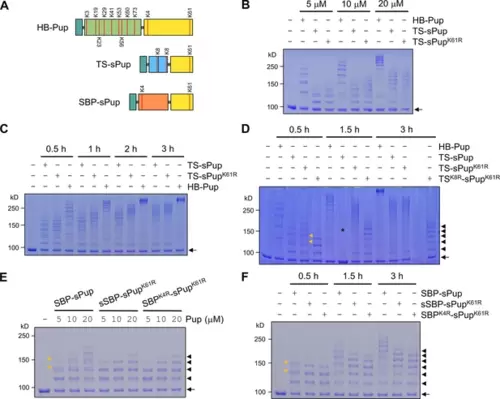Fig. 1 - Supplemental 2
- ID
- ZDB-FIG-250204-16
- Publication
- Sun et al., 2024 - Target protein identification in live cells and organisms with a non-diffusive proximity tagging system
- Other Figures
-
- Fig. 1
- Fig. 1 - Supplemental 1
- Fig. 1 - Supplemental 2
- Fig. 1 - Supplemental 3
- Fig. 2
- Fig. 2 - Supplemental 1
- Fig. 2 - Supplemental 2
- Fig. 2 - Supplemental 3
- Fig. 2 - Supplemental 4
- Fig. 3
- Fig. 3 - Supplemental 1
- Fig. 3 - Supplemental 2
- Fig. 3 - Supplemental 3
- Fig. 4
- Fig. 4 - Supplemental 1
- Fig. 4 - Supplemental 2
- Fig. 4 - Supplemental 3
- Fig. 4 - Supplemental 4
- Fig. 4 - Supplemental 5
- Fig. 4 - Supplemental 6
- Fig. 4 - Supplemetal 7
- Fig. 5
- Fig. 6
- Fig. 6 - Supplemental 1
- Fig. 6 - Supplemental 2
- Fig. 6 - Supplemental 3
- Fig. 6 - Supplemental 4
- Fig. 6 - Supplemental 5
- Fig. 6 - Supplemental 6
- Fig. 7
- Fig. 7 - Supplemental 1
- All Figure Page
- Back to All Figure Page
|
Lysine-mutated Pup substrates bypass polypupylation while retaining activities comparable to wild-type Pup. (A) A schematic shows the lysine residues in HB-Pup, TS-sPup, and SBP-sPup. (B) In a pupylation assay, Halo-PafA exhibits dose-dependent self-pupylation with different concentrations of HB-Pup, TS-sPup, or TS-sPupK61R for 30 min. (C) Time-dependent polypupylation becomes evident, particularly after 1 hr incubation, as seen by high molecular weight bands. (D) Removing all lysine residues from TS-sPup completely prevents polypupylation. The asterisk indicates a possible experimental error causing a failed pupylation. (E) Eliminating lysine residues in SBP and sPup completely abolishes polypupylation. Halo-PafA was incubated with various concentrations of SBP-sPup, sSBP-sPupK61R, or SBPK4R-sPupK61R for 30 min. (F) Longer incubations do not induce polypupylation but enhance multipupylation in the cases of sSBP-sPupK61R and SBPK4R-sPupK61R. All reactions were performed with 1 μM of Halo-PafA and 10 μM of HB-Pup, TS-sPup, or TS-sPupK61R at 37°C. Yellow arrowheads point to polypupylated bands that are not detected in polypupylation-free sPup substrates. Black arrowheads and arrows indicate multipupylated bands and Halo-PafA, respectively. |

